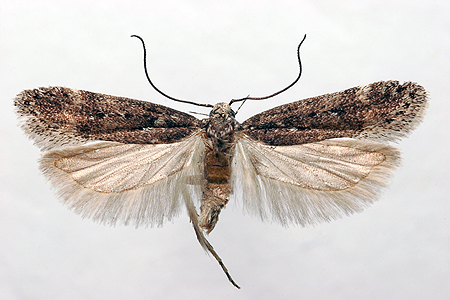Pests
Scrobipalpa ocellatella (Boyd) - Beet Moth
Synonyms.
Euscrobipalpa ocellalella Boyd, Gnorimoschema ocellatellum Boyd, Phthorimaea ocellatella Boyd.Systematic position.
Class Insecta, order Lepidoptera, superfamily Gelechioidea, family Gelechiidae, subfamily Gelechiinae, genus Scrobipalpa.Biological group.
Pest of beet.Morphology and biology.
Forewings of the moth narrow, pointed, gray-brown, with yellow pattern and small black spots (wingspan 12-14 mm). Hindwings trapezoid, with emargination at apex, light gray, with a fringe of long cilia. Egg oval, white, with nacreous tint, 0.5 mm in length. Caterpillar 10-12 mm long, gray-green in last instar with five interrupted longitudinal pinkish stripes. Its body from above and along each side has brown tubercles bearing setae. Pupa 5.0-6.5 mm long, bright-brown, inserted in silky cocoon. Caterpillars of all instars and pupae winter in a surface layer of ground, within vegetation residues in fields, in non-harvested beet roots, and sometimes in storing beet roots. Usually only pupae and late caterpillars overwinter successfully. Females lay eggs on both sides of beet leaves and on petioles. Fertility is 200 eggs. Embryonal development lasts 4-12 days. Hatching caterpillars hide at petiole base or within bent edges of young leaflets of the central rosette. They develop 20-30 days, passing 5 instars. Caterpillars often pupate in a surface layer of ground at a depth of 1-5 sm within small oblong cocoons covered with soil particles. Moths of new generation appear in 10-20 days.Distribution.
Middle and South Europe, Northern Africa, Middle East, Iran. In the former USSR, the species is distributed in the Central Chernozem Region (sparsely), in the south of the European part of Russia to the Caucasus, in Ukraine, Moldova, Transcaucasia (Georgia), Central Asia (Turkmenistan).Ecology.
The species has 4-5 generations in the south of the European part of Russia and Ukraine. Moth flight after wintering begins in April, during shooting of beet in spring. Simultaneously, pupation of wintered caterpillars occurs. Moth flight is prolonged, continuing more than a month. Moths meet from April through August, inclusive. One generation develops 40-65 days. The pest numbers increase in every following generation, reaching maximum by the end of summer. Moth fertility rises when pupae develop under damp weather conditions, falling sharply during drought. Young caterpillars are hygrophilous, perishing under dry weather conditions. The caterpillars are destroyed by frost in snowless winters. The pupa is the most winter-hardy stage. Optimum hydrothermal conditions for the pest are temperature 20-25°C and relative air humidity 70-85%. The caterpillars cause the greatest harm during dry weather when beet plants lose the most part of their leaves, and the caterpillars injure growing point of beet. Caterpillars and pupae are infested by many species of parasitic Hymenoptera (in some years killing to 45-60%). Prevailing parasites are braconids and a fly Chelonella sp.Economic significance.
This is a dangerous pest of beet, especially sugar beet; to a lesser degree table beet and fodder beet. Caterpillars can also feed on other plants of the family Chenopodiaceae (pigweed, seablite, saltwort etc.). The caterpillars skeletonize leaves, braiding them with silk threads. In spring and in the beginning of summer, they mine leaves, usually along main veins, also piercing holes in petioles. The damaged leaves roll and blacken. A black clump of rotten leaves fastened with silk threads is formed instead of the central rosette. In hot and dry years, such damage frequently causes the whole plant to die since the outer leaves die off quickly and new ones are not formed because of the central rosette loss. Caterpillars of the following generations penetrate into roots. In the upper part of the roots they gnaw out narrow, twisting grooves or holes under thin skin, sometimes boring to a depth of 5 cm. These holes under skin also injure lateral parts of roots. The damaged roots become languid and rotten. In parent beet plants, the caterpillars injure flower buds, unripe seeds, and tips of growing floriferous stalks, piercing holes; as a result, the stalks are bent, and yield of seeds sharply falls. Control measures are as follows. Agronomical ones include careful harvesting of roots and leaves where the older caterpillars can finish their development before plant rotting; autumn deep plowing (25-27 cm) that is most effective at daily average temperature to 5-6°C when the caterpillars are inactive, not able to get out on soil surface. Chemical measures include insecticide treatments of beet crops and plantings during mass oviposition by moths of each generation.Reference citations:
L.vovskii A.L. & Piskunov V.I. 1999. Fam. Gelechiidae - wing-emarginated moths. In: Kuznetsov V.I., ed. Insects and mites . pests of agricultural crops. Lepidoptera. St. Petersburg: Nauka. V. 3, part 2, p. 46-93 (in Russian).Minoranskii V.A. 1963. Beet Mining Moth. Zashchita rastenii ot vreditelei i boleznei 3: 30-31 (in Russian).
Minoranskii V.A. 1987. Formation of noxious entomofauna on beet plantations. Zashchita rastenii 11: 32-34 (in Russian).
Petrukha O.I., Pozhar Z.A., Shevchenko V.N., Bichuk Yu.P., Pshenichuk R.F., Tishchenko E.I., Tribel. S.A., Broyakovskaya O.N. & Kornienko A.S. 1982. Sugar-beet protection. Zashchita rastenii 6: 23-26 (in Russian).
Shmeleva V.A. 1954. Beet Mining Moth and its control. Kiev: AN Ukr. SSR, 38 p. (in Russian).
Slavgorodskaya-Kurpieva L.E., Slavgorodskii V.E. & Popov V.G. 2001. Protection of agricultural crops against pests and diseases. (The handbook for farmers, gardeners, truck farmers). Simferopol.: Biznes-Inform, 344 p. (in Russian).
Tribel. S.A. & Deryugin E.A. 1993. Biocenotic mechanisms of control of harmfulness. Sakharnaya svekla 3: 19-20 (in Russian).
Vasil.ev V.P. 1974. Family Gelechiidae. In: Vasil.ev V.P., ed. Pests of agricultural crops and forest plantations. V.2. Arthropods. Kiev: Urozhai, p. 257-261 (in Russian).
Zhitkevich E.N. 1963. Beet Mining Moth. Zashchita rastenii ot vreditelei i boleznei 3: 29-30 (in Russian).


